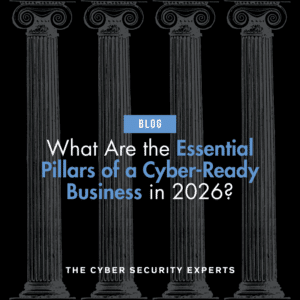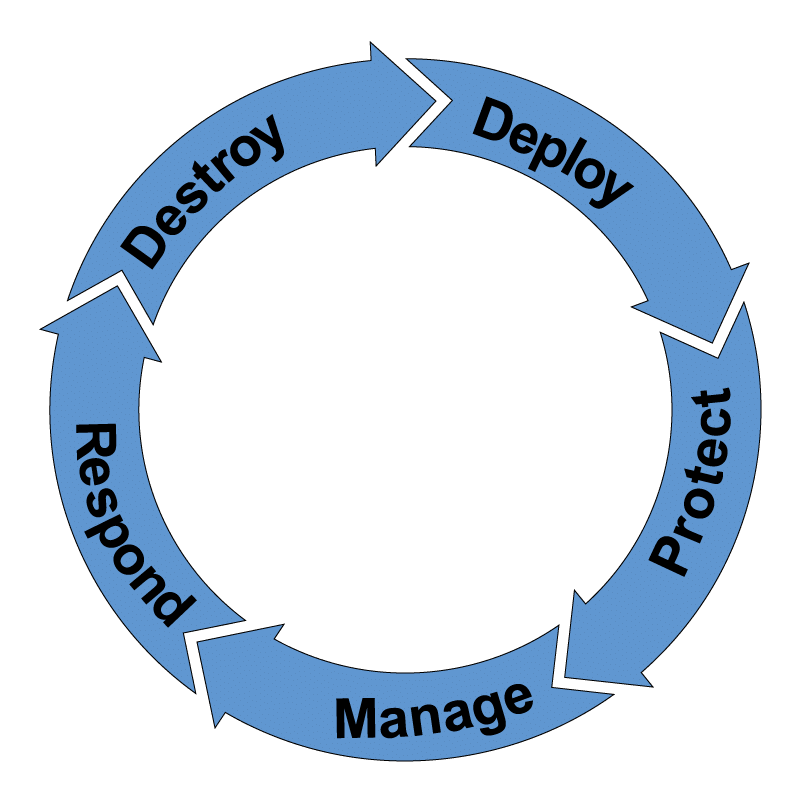What Are the Essential Pillars of a Cyber-Ready Business in 2026?
 Cyberattacks are no longer rare events. For small to mid-sized businesses (SMBs), they’ve become inevitable moments of truth that test your preparedness, resilience, and leadership. Whether you’re leading a community bank, healthcare organization, accounting firm, or government entity, the question is no longer if your organization will face an incident…but when.
Cyberattacks are no longer rare events. For small to mid-sized businesses (SMBs), they’ve become inevitable moments of truth that test your preparedness, resilience, and leadership. Whether you’re leading a community bank, healthcare organization, accounting firm, or government entity, the question is no longer if your organization will face an incident…but when.
Fortunately, creating a cyber-ready business doesn’t require an unlimited budget or a large internal security team. Instead, it requires a strategic cyber strategy, intentional practices, and strong partnerships with a Managed Security Service Provider (MSSP) who can extend your team’s capabilities.
This article examines the six pillars of cyber readiness and their significance for business leaders preparing for 2026.
1. Risk Awareness: Do You Know What’s Most Valuable?
The foundation of any strong cyber strategy is knowing what matters most. You can’t protect what you haven’t identified.
Key question executives should ask: What data, systems, and processes are most critical to daily operations, compliance, and customer trust?
For SMBs in regulated industries, this includes:
- Protected Health Information (PHI) in healthcare
- Customer financial records in community banking
- Client tax files in accounting
- Citizen data in state and local government
Without clear asset mapping, cyber budgets become guesswork. By performing routine risk assessments and asset inventories, you not only identify what’s at stake but also allocate resources strategically – protecting what matters most.
2. Prevention and Protection: Are Your Defenses Layered or Fragile?
Many businesses assume firewalls or endpoint software are enough. But modern attackers exploit weak links in people, processes, and overlooked configurations. That’s why prevention must be layered.
Key executive insight: Cybersecurity isn’t about one tool. It’s about integrating technologies, access controls, and governance into a unified cyber strategy.
Reclamere recommends:
- Multi-Factor Authentication (MFA): Non-negotiable across all access points.
- Endpoint Detection & Response (EDR/MDR): Real-time visibility and response against endpoint threats.
- Role-Based Access Controls: Limiting privileges to “only what’s necessary.”
- Vendor Risk Oversight: Monitoring third-party providers who may create hidden entry points.
When only trusted, validated users have access and when tools are integrated into a layered defense, your risk posture strengthens dramatically.
3. People and Culture: Is Cybersecurity Part of Your Daily Routine?
Technology alone won’t secure your business. Human behavior remains the #1 risk factor, with 95% of breaches tied to human error.
Key question executives should ask: Does my team view cybersecurity as a burden, or as part of their daily responsibility?
Practical steps include:
- Regular phishing simulations to build recognition skills.
- Micro-trainings that fit into daily workflows.
- Open reporting culture: Reward employees for reporting suspicious activity, instead of penalizing mistakes.
At Reclamere, we call this building a “Human Firewall”. When every employee views themselves as part of the security team, resilience multiplies.
How Cyber-Ready Are You, Really?
Download Reclamere’s Cyber-Ready Scorecard to measure your strengths, identify gaps, and take your first step toward resilience.
4. Detection and Monitoring: How Quickly Can You Spot a Breach?
Even the best defenses won’t stop every threat. That’s why early detection is mission-critical.
Key question executives should ask: If an attacker gained access today, how long would it take us to notice?
Industry research shows the average breach takes 279 days to identify and contain in healthcare. For SMBs, that’s nearly a year of silent compromise.
With SOC360 (Security Operations Center as a Service), Reclamere delivers 24/7 monitoring, real-time alerting, and proactive threat hunting – ensuring anomalies are identified and addressed before they escalate into disasters.
5. Response and Recovery: Is Your Playbook Tested or Theoretical?
When a breach occurs, time and clarity are everything. A documented plan on paper isn’t enough – your team must practice, test, and refine response procedures.
Key question executives should ask: If a ransomware attack locked our systems tomorrow, who does what in the first 60 minutes?
A strong Incident Response Plan (IRP) includes:
- Designated incident response team roles.
- Updated vendor and regulator contact lists.
- Tabletop exercises simulating breach scenarios.
- Regular updates to reflect new threats and technologies.
Frequent data backups and tested disaster recovery plans ensure business continuity, even in worst-case scenarios.
6. Continuous Improvement: Are You Learning from Each Event?
Cybersecurity isn’t a “set it and forget it” function. Threat actors innovate constantly, and so must your defenses.
Key question executives should ask: When was the last time we reviewed and updated our cyber strategy?
Continuous improvement means:
- Updating security awareness training content annually.
- Performing post-incident reviews to capture lessons learned.
Reassessing vendor contracts and compliance documentation. - Aligning policies with frameworks like NIST, ISO 27001, CIS Controls.
With maturity models, you can measure progress year over year – ensuring your business gets stronger, not stagnant.
Cyber Readiness = Customer Trust
Customers, regulators, and boards don’t just want to know if you’ve purchased tools. They want assurance that your entire cyber strategy is resilient, tested, and continuously improving. By investing in these six pillars, SMB leaders not only reduce breach risk but also strengthen trust with clients, partners, and regulators.
Ready for Support?
Cyber readiness isn’t just a checklist – it’s a business survival strategy. If managing all the moving parts feels overwhelming, you’re not alone. Partnering with a trusted Managed Security Service Provider (MSSP) like
Reclamere provides:
- Strategic guidance through our CSO360 program.
- 24/7 monitoring and threat detection via SOC360.
- Vendor oversight and accountability with SCR360.
- Secure IT asset lifecycle management through DS360.
The first step to building a cyber strategy that protects your future is understanding your current posture. Download Reclamere’s Cyber-Ready Scorecard and see how your organization measures up across the six pillars of cyber resilience.








